Analysis of Information Systems & Big Data: A Detailed Report
VerifiedAdded on 2023/06/11
|11
|2956
|357
Report
AI Summary
This report provides a comprehensive analysis of information systems and big data, starting with definitions of key terms like Moodle and MS Office, and exploring concepts such as DSS, ESS, TPS, MIS, and KSM. It highlights the impact of globalization on IT and examines digital infrastructure, using cloud services as an example, detailing its advantages and disadvantages. Furthermore, the report discusses the risks associated with information systems outsourcing, including inexperienced staff and dependency on vendors, and emphasizes the crucial role of IT infrastructure in digital transformation. The analysis underscores the importance of adapting to digital advancements for business growth and competitive advantage, concluding that a well-managed IT infrastructure is essential for modern business strategies.
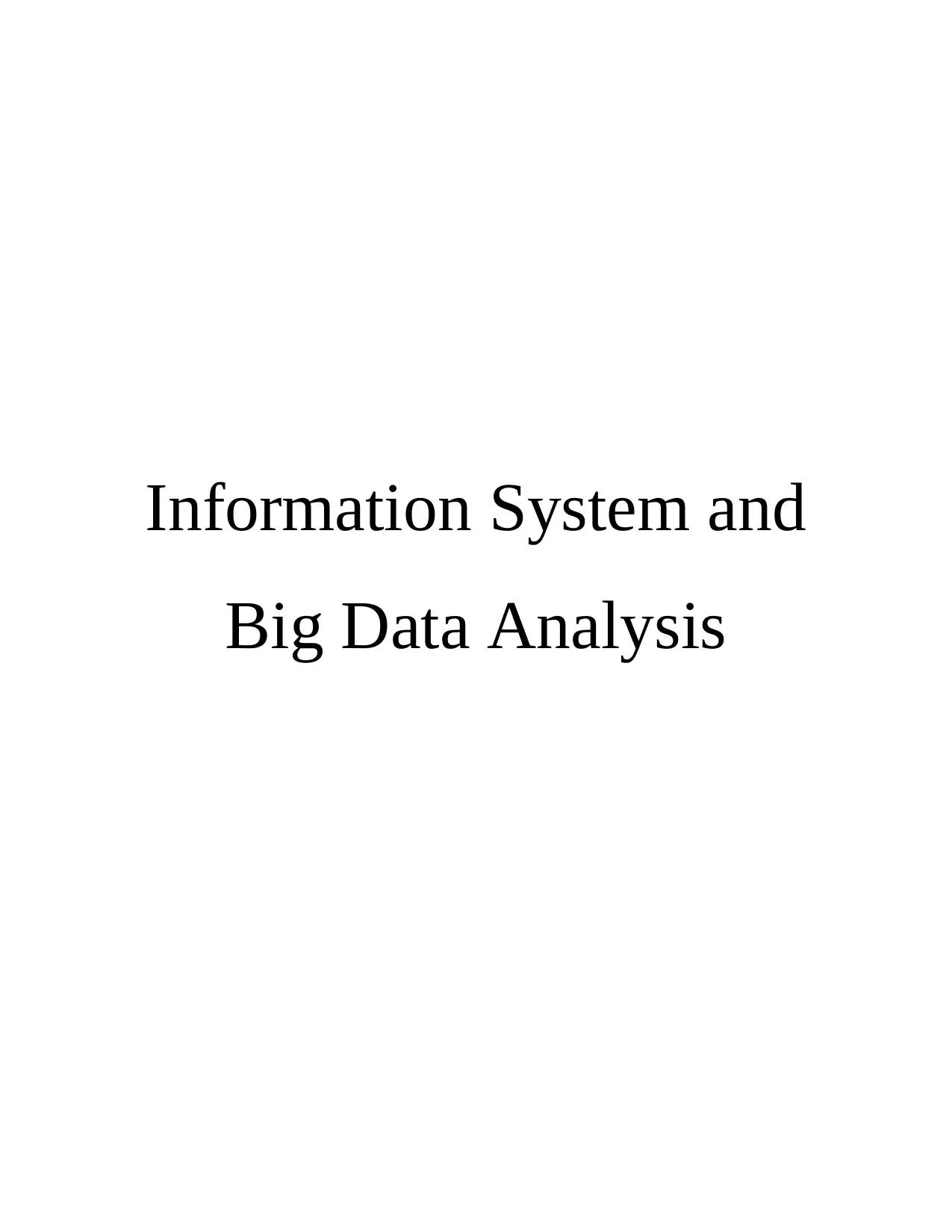
Information System and
Big Data Analysis
Big Data Analysis
Paraphrase This Document
Need a fresh take? Get an instant paraphrase of this document with our AI Paraphraser
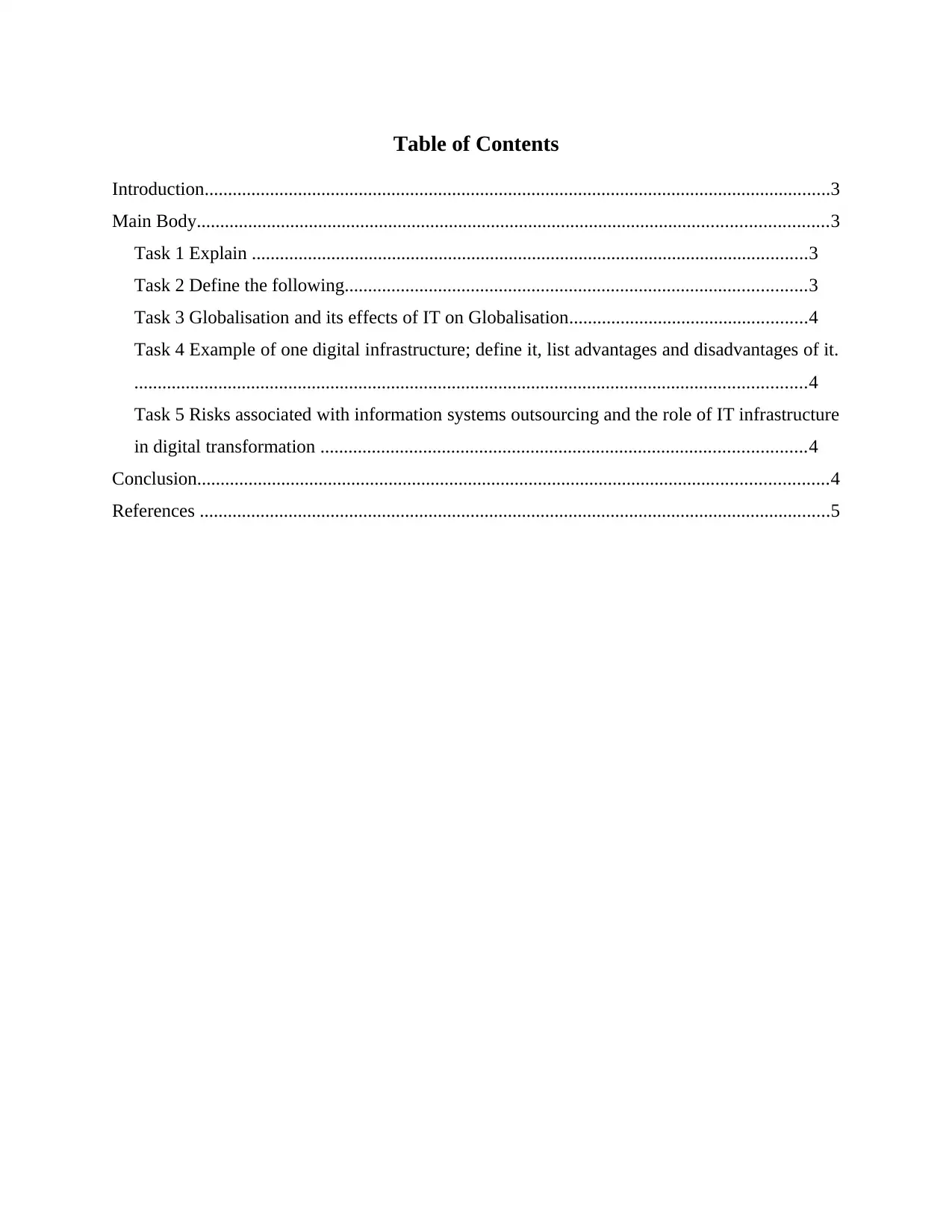
Table of Contents
Introduction......................................................................................................................................3
Main Body.......................................................................................................................................3
Task 1 Explain .......................................................................................................................3
Task 2 Define the following...................................................................................................3
Task 3 Globalisation and its effects of IT on Globalisation...................................................4
Task 4 Example of one digital infrastructure; define it, list advantages and disadvantages of it.
................................................................................................................................................4
Task 5 Risks associated with information systems outsourcing and the role of IT infrastructure
in digital transformation ........................................................................................................4
Conclusion.......................................................................................................................................4
References .......................................................................................................................................5
Introduction......................................................................................................................................3
Main Body.......................................................................................................................................3
Task 1 Explain .......................................................................................................................3
Task 2 Define the following...................................................................................................3
Task 3 Globalisation and its effects of IT on Globalisation...................................................4
Task 4 Example of one digital infrastructure; define it, list advantages and disadvantages of it.
................................................................................................................................................4
Task 5 Risks associated with information systems outsourcing and the role of IT infrastructure
in digital transformation ........................................................................................................4
Conclusion.......................................................................................................................................4
References .......................................................................................................................................5
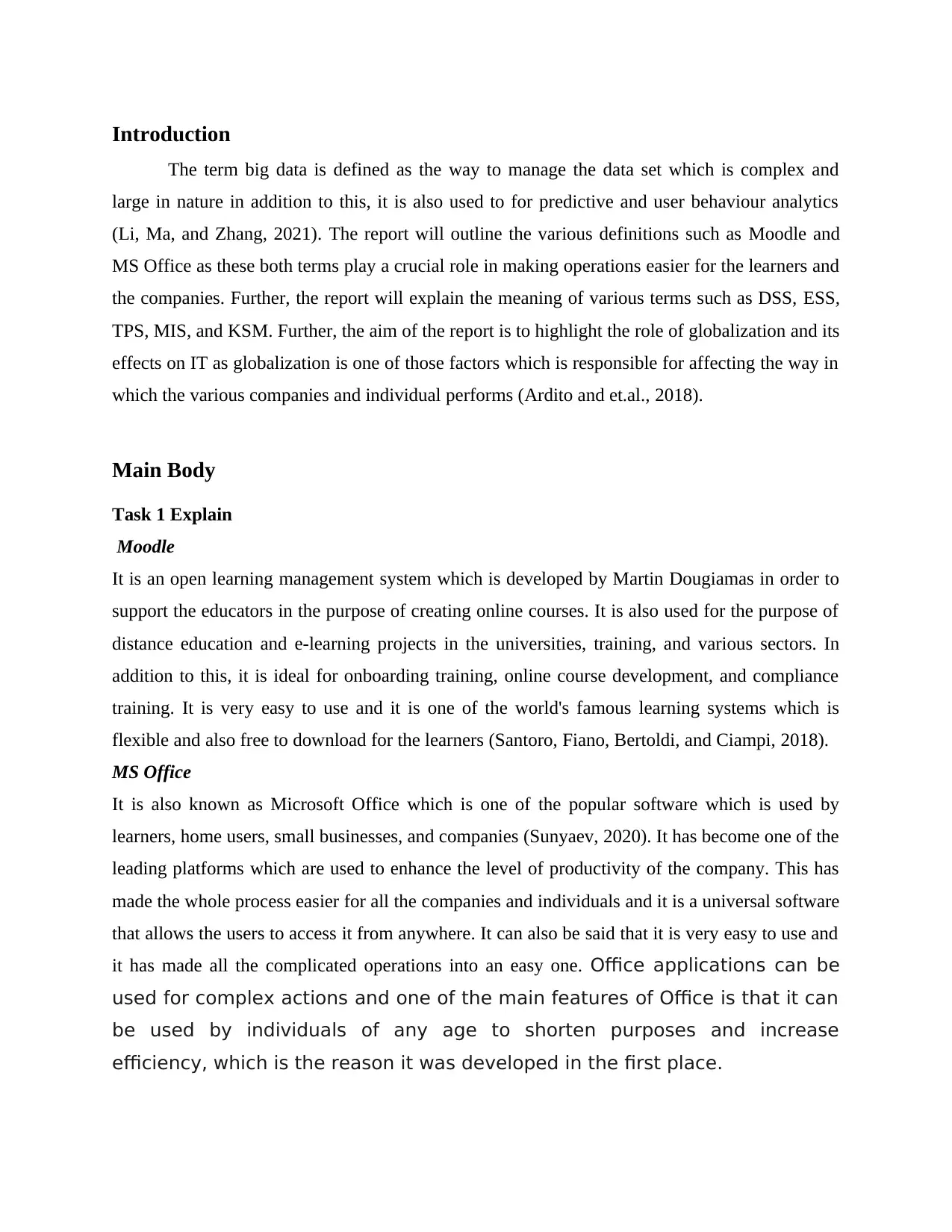
Introduction
The term big data is defined as the way to manage the data set which is complex and
large in nature in addition to this, it is also used to for predictive and user behaviour analytics
(Li, Ma, and Zhang, 2021). The report will outline the various definitions such as Moodle and
MS Office as these both terms play a crucial role in making operations easier for the learners and
the companies. Further, the report will explain the meaning of various terms such as DSS, ESS,
TPS, MIS, and KSM. Further, the aim of the report is to highlight the role of globalization and its
effects on IT as globalization is one of those factors which is responsible for affecting the way in
which the various companies and individual performs (Ardito and et.al., 2018).
Main Body
Task 1 Explain
Moodle
It is an open learning management system which is developed by Martin Dougiamas in order to
support the educators in the purpose of creating online courses. It is also used for the purpose of
distance education and e-learning projects in the universities, training, and various sectors. In
addition to this, it is ideal for onboarding training, online course development, and compliance
training. It is very easy to use and it is one of the world's famous learning systems which is
flexible and also free to download for the learners (Santoro, Fiano, Bertoldi, and Ciampi, 2018).
MS Office
It is also known as Microsoft Office which is one of the popular software which is used by
learners, home users, small businesses, and companies (Sunyaev, 2020). It has become one of the
leading platforms which are used to enhance the level of productivity of the company. This has
made the whole process easier for all the companies and individuals and it is a universal software
that allows the users to access it from anywhere. It can also be said that it is very easy to use and
it has made all the complicated operations into an easy one. Office applications can be
used for complex actions and one of the main features of Office is that it can
be used by individuals of any age to shorten purposes and increase
efficiency, which is the reason it was developed in the first place.
The term big data is defined as the way to manage the data set which is complex and
large in nature in addition to this, it is also used to for predictive and user behaviour analytics
(Li, Ma, and Zhang, 2021). The report will outline the various definitions such as Moodle and
MS Office as these both terms play a crucial role in making operations easier for the learners and
the companies. Further, the report will explain the meaning of various terms such as DSS, ESS,
TPS, MIS, and KSM. Further, the aim of the report is to highlight the role of globalization and its
effects on IT as globalization is one of those factors which is responsible for affecting the way in
which the various companies and individual performs (Ardito and et.al., 2018).
Main Body
Task 1 Explain
Moodle
It is an open learning management system which is developed by Martin Dougiamas in order to
support the educators in the purpose of creating online courses. It is also used for the purpose of
distance education and e-learning projects in the universities, training, and various sectors. In
addition to this, it is ideal for onboarding training, online course development, and compliance
training. It is very easy to use and it is one of the world's famous learning systems which is
flexible and also free to download for the learners (Santoro, Fiano, Bertoldi, and Ciampi, 2018).
MS Office
It is also known as Microsoft Office which is one of the popular software which is used by
learners, home users, small businesses, and companies (Sunyaev, 2020). It has become one of the
leading platforms which are used to enhance the level of productivity of the company. This has
made the whole process easier for all the companies and individuals and it is a universal software
that allows the users to access it from anywhere. It can also be said that it is very easy to use and
it has made all the complicated operations into an easy one. Office applications can be
used for complex actions and one of the main features of Office is that it can
be used by individuals of any age to shorten purposes and increase
efficiency, which is the reason it was developed in the first place.
⊘ This is a preview!⊘
Do you want full access?
Subscribe today to unlock all pages.

Trusted by 1+ million students worldwide
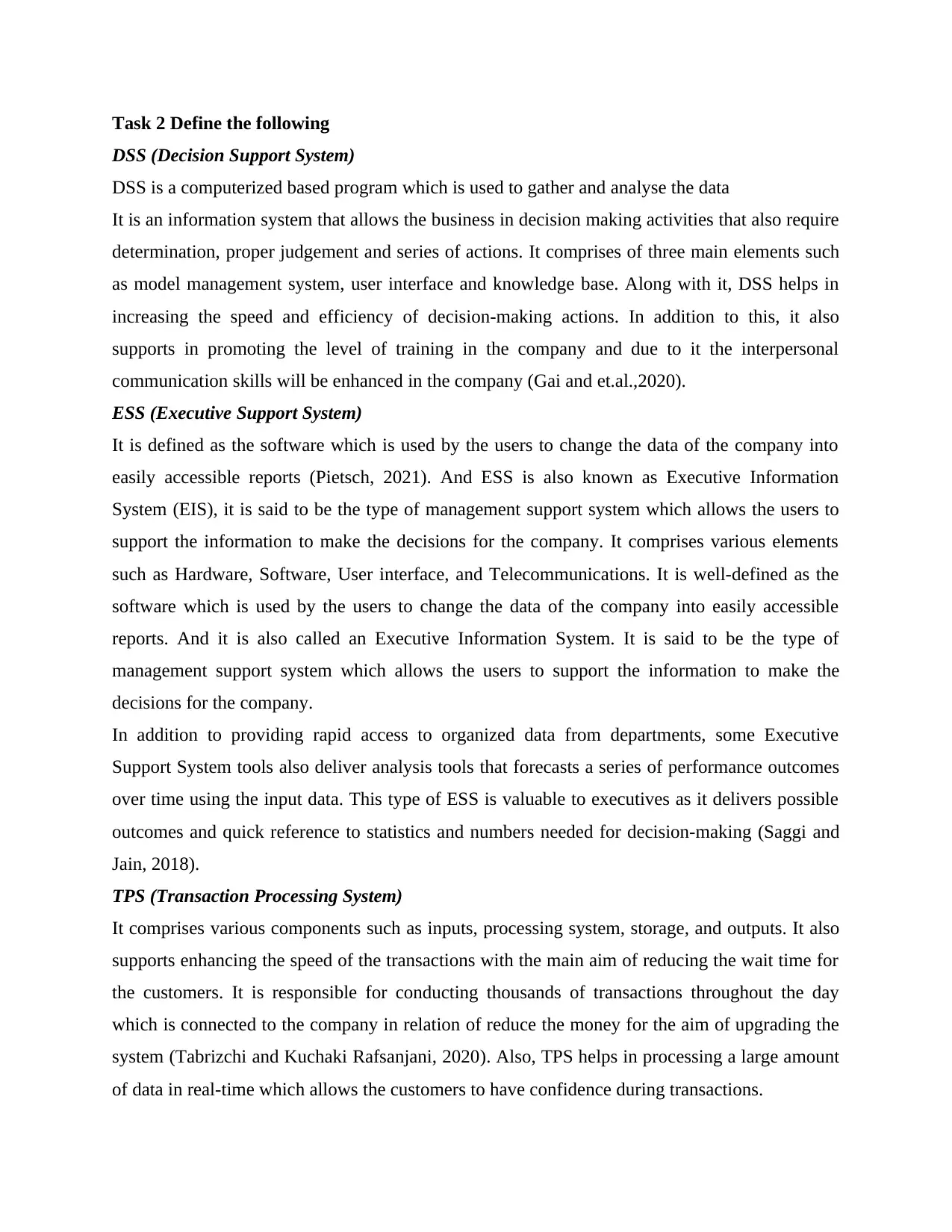
Task 2 Define the following
DSS (Decision Support System)
DSS is a computerized based program which is used to gather and analyse the data
It is an information system that allows the business in decision making activities that also require
determination, proper judgement and series of actions. It comprises of three main elements such
as model management system, user interface and knowledge base. Along with it, DSS helps in
increasing the speed and efficiency of decision-making actions. In addition to this, it also
supports in promoting the level of training in the company and due to it the interpersonal
communication skills will be enhanced in the company (Gai and et.al.,2020).
ESS (Executive Support System)
It is defined as the software which is used by the users to change the data of the company into
easily accessible reports (Pietsch, 2021). And ESS is also known as Executive Information
System (EIS), it is said to be the type of management support system which allows the users to
support the information to make the decisions for the company. It comprises various elements
such as Hardware, Software, User interface, and Telecommunications. It is well-defined as the
software which is used by the users to change the data of the company into easily accessible
reports. And it is also called an Executive Information System. It is said to be the type of
management support system which allows the users to support the information to make the
decisions for the company.
In addition to providing rapid access to organized data from departments, some Executive
Support System tools also deliver analysis tools that forecasts a series of performance outcomes
over time using the input data. This type of ESS is valuable to executives as it delivers possible
outcomes and quick reference to statistics and numbers needed for decision-making (Saggi and
Jain, 2018).
TPS (Transaction Processing System)
It comprises various components such as inputs, processing system, storage, and outputs. It also
supports enhancing the speed of the transactions with the main aim of reducing the wait time for
the customers. It is responsible for conducting thousands of transactions throughout the day
which is connected to the company in relation of reduce the money for the aim of upgrading the
system (Tabrizchi and Kuchaki Rafsanjani, 2020). Also, TPS helps in processing a large amount
of data in real-time which allows the customers to have confidence during transactions.
DSS (Decision Support System)
DSS is a computerized based program which is used to gather and analyse the data
It is an information system that allows the business in decision making activities that also require
determination, proper judgement and series of actions. It comprises of three main elements such
as model management system, user interface and knowledge base. Along with it, DSS helps in
increasing the speed and efficiency of decision-making actions. In addition to this, it also
supports in promoting the level of training in the company and due to it the interpersonal
communication skills will be enhanced in the company (Gai and et.al.,2020).
ESS (Executive Support System)
It is defined as the software which is used by the users to change the data of the company into
easily accessible reports (Pietsch, 2021). And ESS is also known as Executive Information
System (EIS), it is said to be the type of management support system which allows the users to
support the information to make the decisions for the company. It comprises various elements
such as Hardware, Software, User interface, and Telecommunications. It is well-defined as the
software which is used by the users to change the data of the company into easily accessible
reports. And it is also called an Executive Information System. It is said to be the type of
management support system which allows the users to support the information to make the
decisions for the company.
In addition to providing rapid access to organized data from departments, some Executive
Support System tools also deliver analysis tools that forecasts a series of performance outcomes
over time using the input data. This type of ESS is valuable to executives as it delivers possible
outcomes and quick reference to statistics and numbers needed for decision-making (Saggi and
Jain, 2018).
TPS (Transaction Processing System)
It comprises various components such as inputs, processing system, storage, and outputs. It also
supports enhancing the speed of the transactions with the main aim of reducing the wait time for
the customers. It is responsible for conducting thousands of transactions throughout the day
which is connected to the company in relation of reduce the money for the aim of upgrading the
system (Tabrizchi and Kuchaki Rafsanjani, 2020). Also, TPS helps in processing a large amount
of data in real-time which allows the customers to have confidence during transactions.
Paraphrase This Document
Need a fresh take? Get an instant paraphrase of this document with our AI Paraphraser
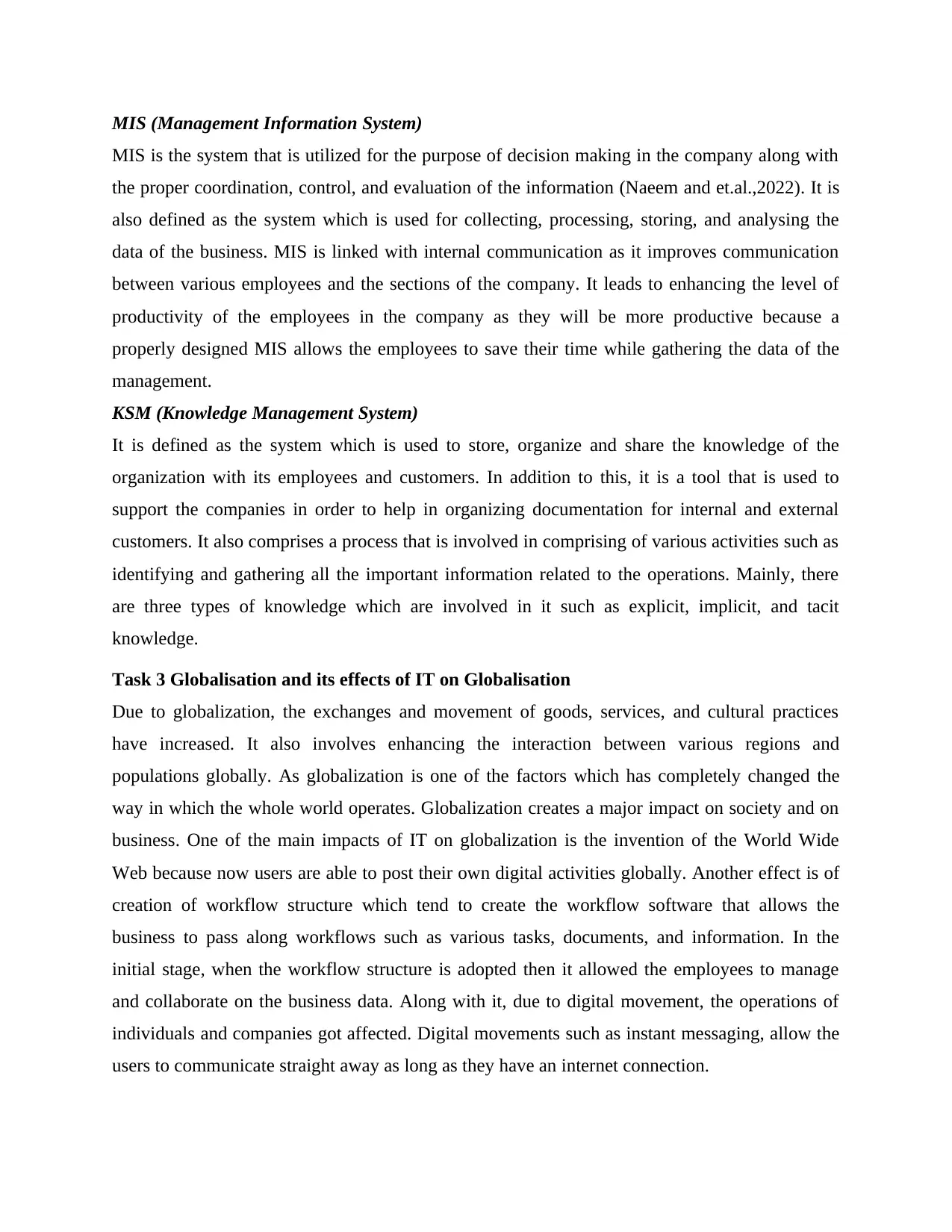
MIS (Management Information System)
MIS is the system that is utilized for the purpose of decision making in the company along with
the proper coordination, control, and evaluation of the information (Naeem and et.al.,2022). It is
also defined as the system which is used for collecting, processing, storing, and analysing the
data of the business. MIS is linked with internal communication as it improves communication
between various employees and the sections of the company. It leads to enhancing the level of
productivity of the employees in the company as they will be more productive because a
properly designed MIS allows the employees to save their time while gathering the data of the
management.
KSM (Knowledge Management System)
It is defined as the system which is used to store, organize and share the knowledge of the
organization with its employees and customers. In addition to this, it is a tool that is used to
support the companies in order to help in organizing documentation for internal and external
customers. It also comprises a process that is involved in comprising of various activities such as
identifying and gathering all the important information related to the operations. Mainly, there
are three types of knowledge which are involved in it such as explicit, implicit, and tacit
knowledge.
Task 3 Globalisation and its effects of IT on Globalisation
Due to globalization, the exchanges and movement of goods, services, and cultural practices
have increased. It also involves enhancing the interaction between various regions and
populations globally. As globalization is one of the factors which has completely changed the
way in which the whole world operates. Globalization creates a major impact on society and on
business. One of the main impacts of IT on globalization is the invention of the World Wide
Web because now users are able to post their own digital activities globally. Another effect is of
creation of workflow structure which tend to create the workflow software that allows the
business to pass along workflows such as various tasks, documents, and information. In the
initial stage, when the workflow structure is adopted then it allowed the employees to manage
and collaborate on the business data. Along with it, due to digital movement, the operations of
individuals and companies got affected. Digital movements such as instant messaging, allow the
users to communicate straight away as long as they have an internet connection.
MIS is the system that is utilized for the purpose of decision making in the company along with
the proper coordination, control, and evaluation of the information (Naeem and et.al.,2022). It is
also defined as the system which is used for collecting, processing, storing, and analysing the
data of the business. MIS is linked with internal communication as it improves communication
between various employees and the sections of the company. It leads to enhancing the level of
productivity of the employees in the company as they will be more productive because a
properly designed MIS allows the employees to save their time while gathering the data of the
management.
KSM (Knowledge Management System)
It is defined as the system which is used to store, organize and share the knowledge of the
organization with its employees and customers. In addition to this, it is a tool that is used to
support the companies in order to help in organizing documentation for internal and external
customers. It also comprises a process that is involved in comprising of various activities such as
identifying and gathering all the important information related to the operations. Mainly, there
are three types of knowledge which are involved in it such as explicit, implicit, and tacit
knowledge.
Task 3 Globalisation and its effects of IT on Globalisation
Due to globalization, the exchanges and movement of goods, services, and cultural practices
have increased. It also involves enhancing the interaction between various regions and
populations globally. As globalization is one of the factors which has completely changed the
way in which the whole world operates. Globalization creates a major impact on society and on
business. One of the main impacts of IT on globalization is the invention of the World Wide
Web because now users are able to post their own digital activities globally. Another effect is of
creation of workflow structure which tend to create the workflow software that allows the
business to pass along workflows such as various tasks, documents, and information. In the
initial stage, when the workflow structure is adopted then it allowed the employees to manage
and collaborate on the business data. Along with it, due to digital movement, the operations of
individuals and companies got affected. Digital movements such as instant messaging, allow the
users to communicate straight away as long as they have an internet connection.
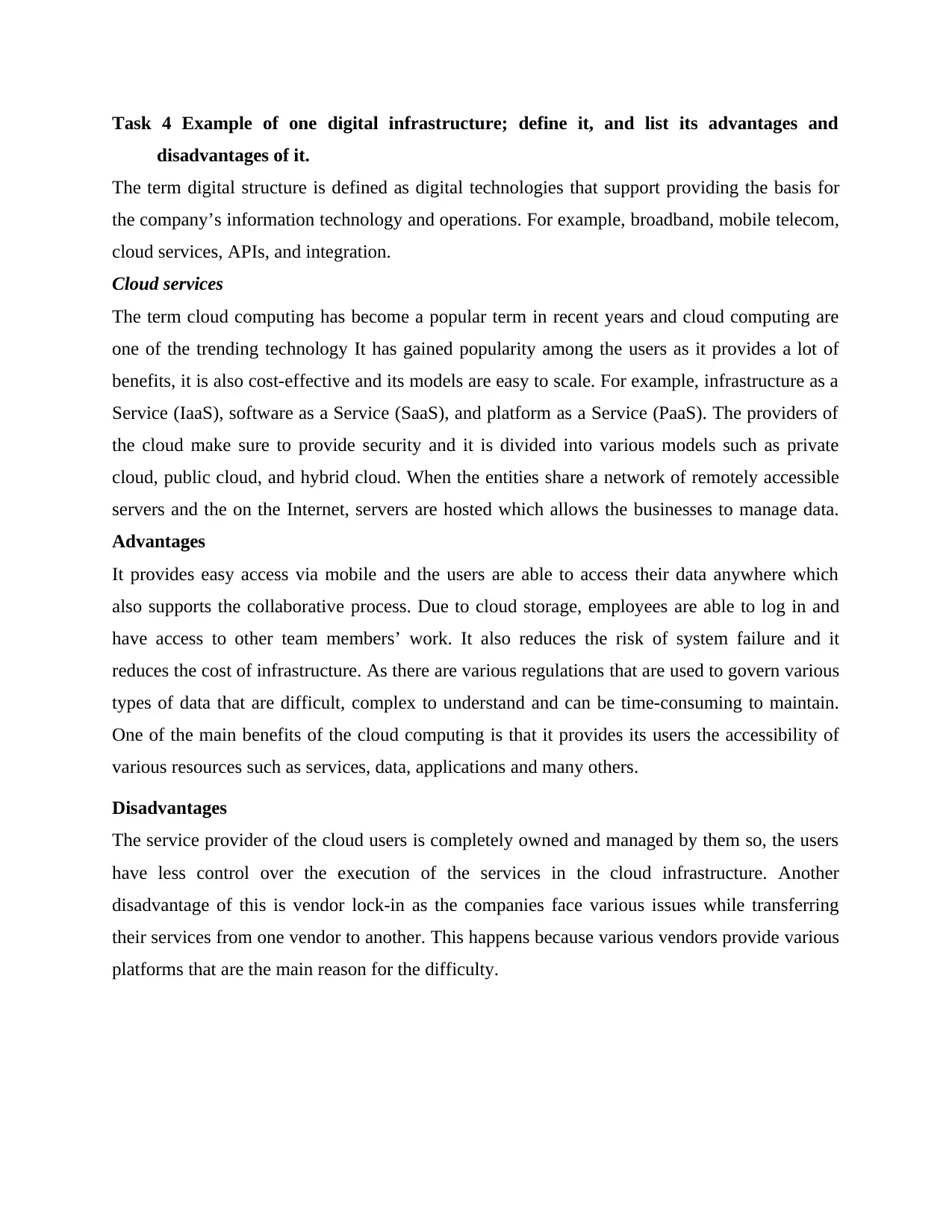
Task 4 Example of one digital infrastructure; define it, and list its advantages and
disadvantages of it.
The term digital structure is defined as digital technologies that support providing the basis for
the company’s information technology and operations. For example, broadband, mobile telecom,
cloud services, APIs, and integration.
Cloud services
The term cloud computing has become a popular term in recent years and cloud computing are
one of the trending technology It has gained popularity among the users as it provides a lot of
benefits, it is also cost-effective and its models are easy to scale. For example, infrastructure as a
Service (IaaS), software as a Service (SaaS), and platform as a Service (PaaS). The providers of
the cloud make sure to provide security and it is divided into various models such as private
cloud, public cloud, and hybrid cloud. When the entities share a network of remotely accessible
servers and the on the Internet, servers are hosted which allows the businesses to manage data.
Advantages
It provides easy access via mobile and the users are able to access their data anywhere which
also supports the collaborative process. Due to cloud storage, employees are able to log in and
have access to other team members’ work. It also reduces the risk of system failure and it
reduces the cost of infrastructure. As there are various regulations that are used to govern various
types of data that are difficult, complex to understand and can be time-consuming to maintain.
One of the main benefits of the cloud computing is that it provides its users the accessibility of
various resources such as services, data, applications and many others.
Disadvantages
The service provider of the cloud users is completely owned and managed by them so, the users
have less control over the execution of the services in the cloud infrastructure. Another
disadvantage of this is vendor lock-in as the companies face various issues while transferring
their services from one vendor to another. This happens because various vendors provide various
platforms that are the main reason for the difficulty.
disadvantages of it.
The term digital structure is defined as digital technologies that support providing the basis for
the company’s information technology and operations. For example, broadband, mobile telecom,
cloud services, APIs, and integration.
Cloud services
The term cloud computing has become a popular term in recent years and cloud computing are
one of the trending technology It has gained popularity among the users as it provides a lot of
benefits, it is also cost-effective and its models are easy to scale. For example, infrastructure as a
Service (IaaS), software as a Service (SaaS), and platform as a Service (PaaS). The providers of
the cloud make sure to provide security and it is divided into various models such as private
cloud, public cloud, and hybrid cloud. When the entities share a network of remotely accessible
servers and the on the Internet, servers are hosted which allows the businesses to manage data.
Advantages
It provides easy access via mobile and the users are able to access their data anywhere which
also supports the collaborative process. Due to cloud storage, employees are able to log in and
have access to other team members’ work. It also reduces the risk of system failure and it
reduces the cost of infrastructure. As there are various regulations that are used to govern various
types of data that are difficult, complex to understand and can be time-consuming to maintain.
One of the main benefits of the cloud computing is that it provides its users the accessibility of
various resources such as services, data, applications and many others.
Disadvantages
The service provider of the cloud users is completely owned and managed by them so, the users
have less control over the execution of the services in the cloud infrastructure. Another
disadvantage of this is vendor lock-in as the companies face various issues while transferring
their services from one vendor to another. This happens because various vendors provide various
platforms that are the main reason for the difficulty.
⊘ This is a preview!⊘
Do you want full access?
Subscribe today to unlock all pages.

Trusted by 1+ million students worldwide
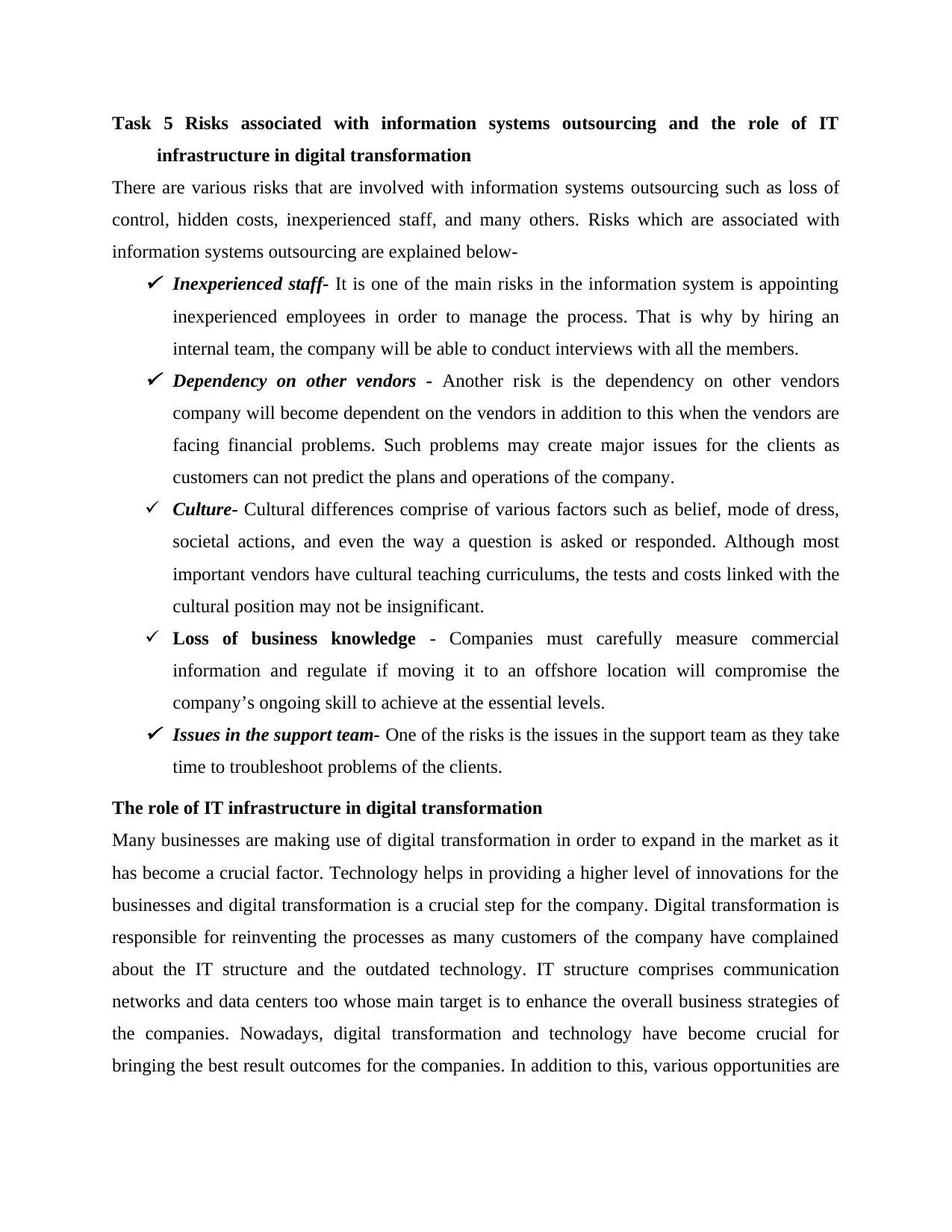
Task 5 Risks associated with information systems outsourcing and the role of IT
infrastructure in digital transformation
There are various risks that are involved with information systems outsourcing such as loss of
control, hidden costs, inexperienced staff, and many others. Risks which are associated with
information systems outsourcing are explained below- Inexperienced staff- It is one of the main risks in the information system is appointing
inexperienced employees in order to manage the process. That is why by hiring an
internal team, the company will be able to conduct interviews with all the members. Dependency on other vendors - Another risk is the dependency on other vendors
company will become dependent on the vendors in addition to this when the vendors are
facing financial problems. Such problems may create major issues for the clients as
customers can not predict the plans and operations of the company.
Culture- Cultural differences comprise of various factors such as belief, mode of dress,
societal actions, and even the way a question is asked or responded. Although most
important vendors have cultural teaching curriculums, the tests and costs linked with the
cultural position may not be insignificant.
Loss of business knowledge - Companies must carefully measure commercial
information and regulate if moving it to an offshore location will compromise the
company’s ongoing skill to achieve at the essential levels. Issues in the support team- One of the risks is the issues in the support team as they take
time to troubleshoot problems of the clients.
The role of IT infrastructure in digital transformation
Many businesses are making use of digital transformation in order to expand in the market as it
has become a crucial factor. Technology helps in providing a higher level of innovations for the
businesses and digital transformation is a crucial step for the company. Digital transformation is
responsible for reinventing the processes as many customers of the company have complained
about the IT structure and the outdated technology. IT structure comprises communication
networks and data centers too whose main target is to enhance the overall business strategies of
the companies. Nowadays, digital transformation and technology have become crucial for
bringing the best result outcomes for the companies. In addition to this, various opportunities are
infrastructure in digital transformation
There are various risks that are involved with information systems outsourcing such as loss of
control, hidden costs, inexperienced staff, and many others. Risks which are associated with
information systems outsourcing are explained below- Inexperienced staff- It is one of the main risks in the information system is appointing
inexperienced employees in order to manage the process. That is why by hiring an
internal team, the company will be able to conduct interviews with all the members. Dependency on other vendors - Another risk is the dependency on other vendors
company will become dependent on the vendors in addition to this when the vendors are
facing financial problems. Such problems may create major issues for the clients as
customers can not predict the plans and operations of the company.
Culture- Cultural differences comprise of various factors such as belief, mode of dress,
societal actions, and even the way a question is asked or responded. Although most
important vendors have cultural teaching curriculums, the tests and costs linked with the
cultural position may not be insignificant.
Loss of business knowledge - Companies must carefully measure commercial
information and regulate if moving it to an offshore location will compromise the
company’s ongoing skill to achieve at the essential levels. Issues in the support team- One of the risks is the issues in the support team as they take
time to troubleshoot problems of the clients.
The role of IT infrastructure in digital transformation
Many businesses are making use of digital transformation in order to expand in the market as it
has become a crucial factor. Technology helps in providing a higher level of innovations for the
businesses and digital transformation is a crucial step for the company. Digital transformation is
responsible for reinventing the processes as many customers of the company have complained
about the IT structure and the outdated technology. IT structure comprises communication
networks and data centers too whose main target is to enhance the overall business strategies of
the companies. Nowadays, digital transformation and technology have become crucial for
bringing the best result outcomes for the companies. In addition to this, various opportunities are
Paraphrase This Document
Need a fresh take? Get an instant paraphrase of this document with our AI Paraphraser
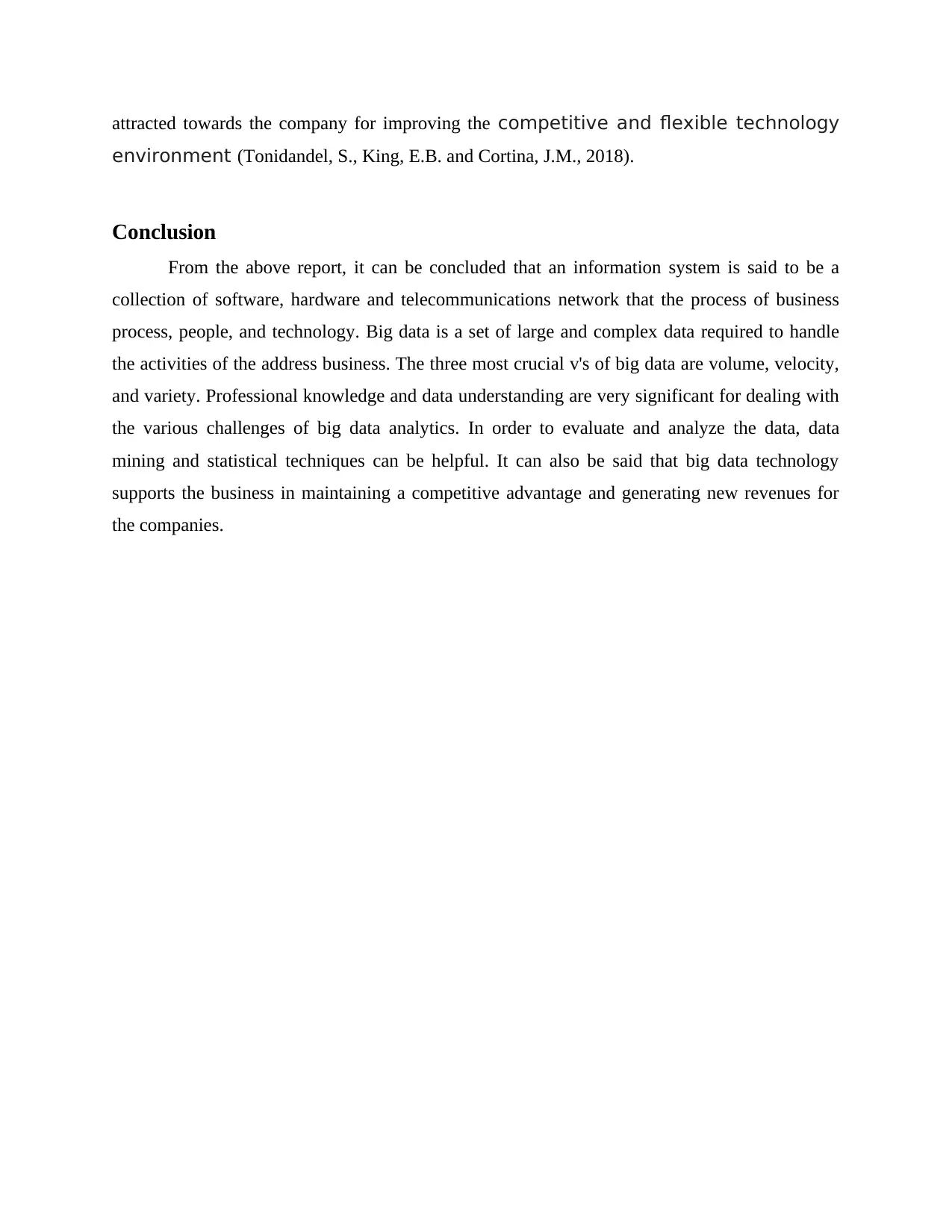
attracted towards the company for improving the competitive and flexible technology
environment (Tonidandel, S., King, E.B. and Cortina, J.M., 2018).
Conclusion
From the above report, it can be concluded that an information system is said to be a
collection of software, hardware and telecommunications network that the process of business
process, people, and technology. Big data is a set of large and complex data required to handle
the activities of the address business. The three most crucial v's of big data are volume, velocity,
and variety. Professional knowledge and data understanding are very significant for dealing with
the various challenges of big data analytics. In order to evaluate and analyze the data, data
mining and statistical techniques can be helpful. It can also be said that big data technology
supports the business in maintaining a competitive advantage and generating new revenues for
the companies.
environment (Tonidandel, S., King, E.B. and Cortina, J.M., 2018).
Conclusion
From the above report, it can be concluded that an information system is said to be a
collection of software, hardware and telecommunications network that the process of business
process, people, and technology. Big data is a set of large and complex data required to handle
the activities of the address business. The three most crucial v's of big data are volume, velocity,
and variety. Professional knowledge and data understanding are very significant for dealing with
the various challenges of big data analytics. In order to evaluate and analyze the data, data
mining and statistical techniques can be helpful. It can also be said that big data technology
supports the business in maintaining a competitive advantage and generating new revenues for
the companies.
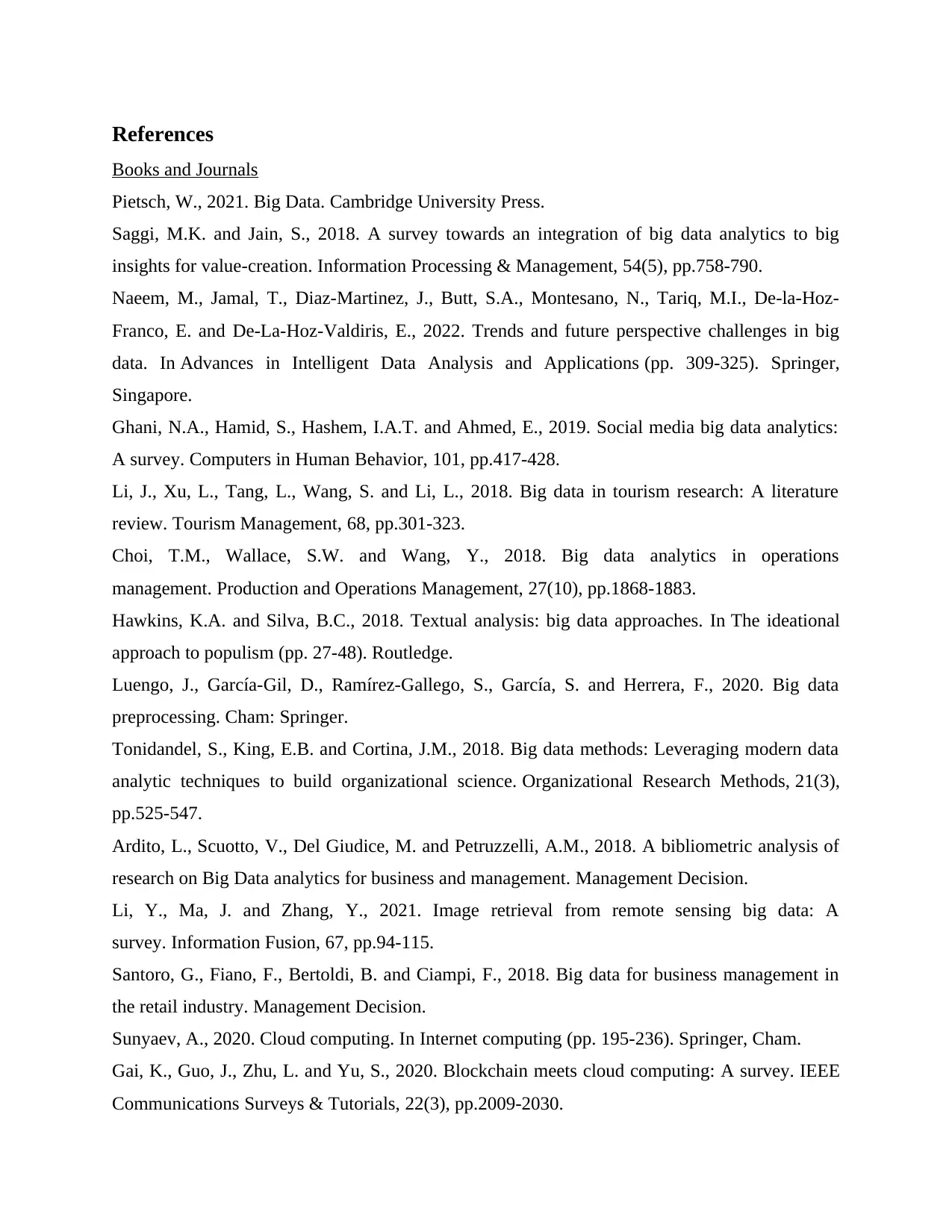
References
Books and Journals
Pietsch, W., 2021. Big Data. Cambridge University Press.
Saggi, M.K. and Jain, S., 2018. A survey towards an integration of big data analytics to big
insights for value-creation. Information Processing & Management, 54(5), pp.758-790.
Naeem, M., Jamal, T., Diaz-Martinez, J., Butt, S.A., Montesano, N., Tariq, M.I., De-la-Hoz-
Franco, E. and De-La-Hoz-Valdiris, E., 2022. Trends and future perspective challenges in big
data. In Advances in Intelligent Data Analysis and Applications (pp. 309-325). Springer,
Singapore.
Ghani, N.A., Hamid, S., Hashem, I.A.T. and Ahmed, E., 2019. Social media big data analytics:
A survey. Computers in Human Behavior, 101, pp.417-428.
Li, J., Xu, L., Tang, L., Wang, S. and Li, L., 2018. Big data in tourism research: A literature
review. Tourism Management, 68, pp.301-323.
Choi, T.M., Wallace, S.W. and Wang, Y., 2018. Big data analytics in operations
management. Production and Operations Management, 27(10), pp.1868-1883.
Hawkins, K.A. and Silva, B.C., 2018. Textual analysis: big data approaches. In The ideational
approach to populism (pp. 27-48). Routledge.
Luengo, J., García-Gil, D., Ramírez-Gallego, S., García, S. and Herrera, F., 2020. Big data
preprocessing. Cham: Springer.
Tonidandel, S., King, E.B. and Cortina, J.M., 2018. Big data methods: Leveraging modern data
analytic techniques to build organizational science. Organizational Research Methods, 21(3),
pp.525-547.
Ardito, L., Scuotto, V., Del Giudice, M. and Petruzzelli, A.M., 2018. A bibliometric analysis of
research on Big Data analytics for business and management. Management Decision.
Li, Y., Ma, J. and Zhang, Y., 2021. Image retrieval from remote sensing big data: A
survey. Information Fusion, 67, pp.94-115.
Santoro, G., Fiano, F., Bertoldi, B. and Ciampi, F., 2018. Big data for business management in
the retail industry. Management Decision.
Sunyaev, A., 2020. Cloud computing. In Internet computing (pp. 195-236). Springer, Cham.
Gai, K., Guo, J., Zhu, L. and Yu, S., 2020. Blockchain meets cloud computing: A survey. IEEE
Communications Surveys & Tutorials, 22(3), pp.2009-2030.
Books and Journals
Pietsch, W., 2021. Big Data. Cambridge University Press.
Saggi, M.K. and Jain, S., 2018. A survey towards an integration of big data analytics to big
insights for value-creation. Information Processing & Management, 54(5), pp.758-790.
Naeem, M., Jamal, T., Diaz-Martinez, J., Butt, S.A., Montesano, N., Tariq, M.I., De-la-Hoz-
Franco, E. and De-La-Hoz-Valdiris, E., 2022. Trends and future perspective challenges in big
data. In Advances in Intelligent Data Analysis and Applications (pp. 309-325). Springer,
Singapore.
Ghani, N.A., Hamid, S., Hashem, I.A.T. and Ahmed, E., 2019. Social media big data analytics:
A survey. Computers in Human Behavior, 101, pp.417-428.
Li, J., Xu, L., Tang, L., Wang, S. and Li, L., 2018. Big data in tourism research: A literature
review. Tourism Management, 68, pp.301-323.
Choi, T.M., Wallace, S.W. and Wang, Y., 2018. Big data analytics in operations
management. Production and Operations Management, 27(10), pp.1868-1883.
Hawkins, K.A. and Silva, B.C., 2018. Textual analysis: big data approaches. In The ideational
approach to populism (pp. 27-48). Routledge.
Luengo, J., García-Gil, D., Ramírez-Gallego, S., García, S. and Herrera, F., 2020. Big data
preprocessing. Cham: Springer.
Tonidandel, S., King, E.B. and Cortina, J.M., 2018. Big data methods: Leveraging modern data
analytic techniques to build organizational science. Organizational Research Methods, 21(3),
pp.525-547.
Ardito, L., Scuotto, V., Del Giudice, M. and Petruzzelli, A.M., 2018. A bibliometric analysis of
research on Big Data analytics for business and management. Management Decision.
Li, Y., Ma, J. and Zhang, Y., 2021. Image retrieval from remote sensing big data: A
survey. Information Fusion, 67, pp.94-115.
Santoro, G., Fiano, F., Bertoldi, B. and Ciampi, F., 2018. Big data for business management in
the retail industry. Management Decision.
Sunyaev, A., 2020. Cloud computing. In Internet computing (pp. 195-236). Springer, Cham.
Gai, K., Guo, J., Zhu, L. and Yu, S., 2020. Blockchain meets cloud computing: A survey. IEEE
Communications Surveys & Tutorials, 22(3), pp.2009-2030.
⊘ This is a preview!⊘
Do you want full access?
Subscribe today to unlock all pages.

Trusted by 1+ million students worldwide
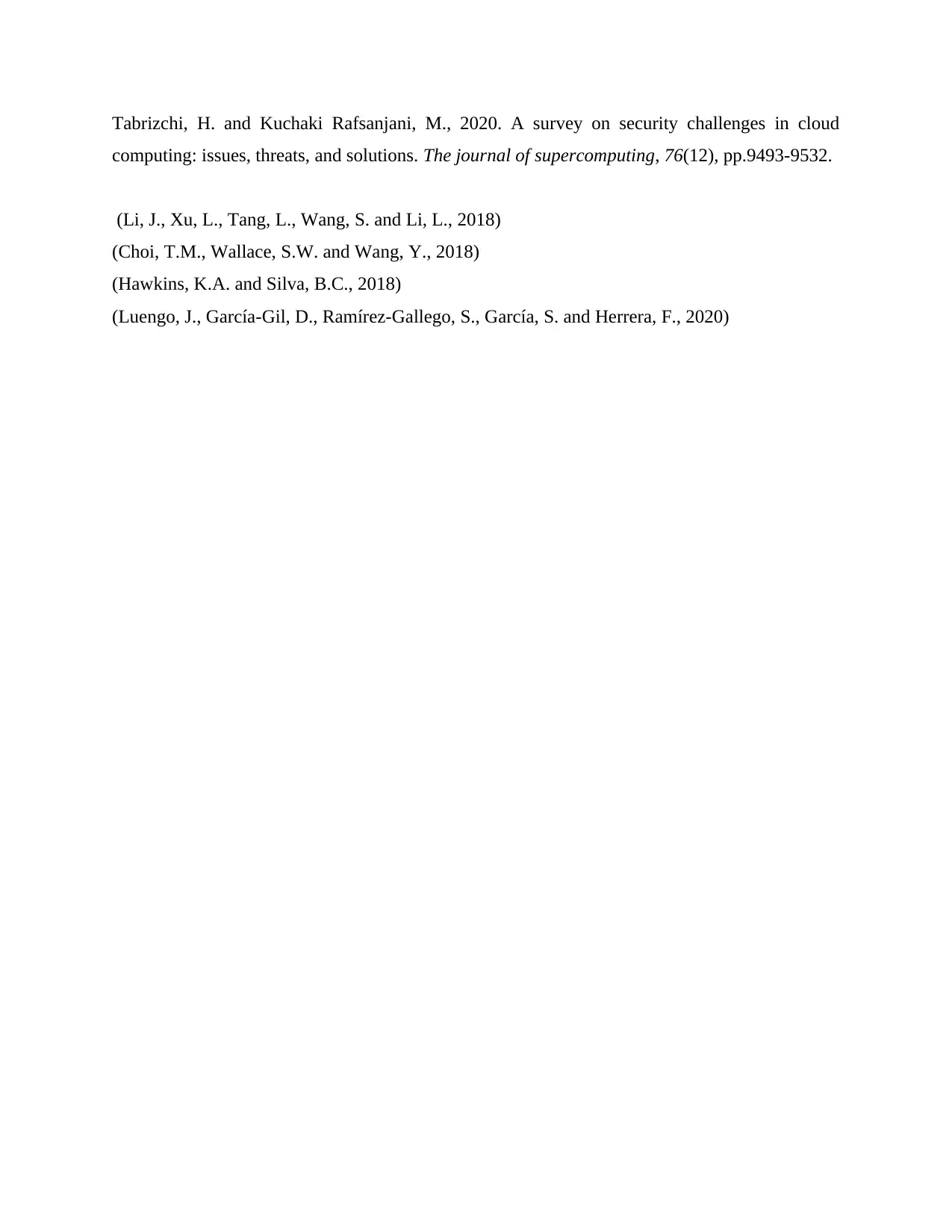
Tabrizchi, H. and Kuchaki Rafsanjani, M., 2020. A survey on security challenges in cloud
computing: issues, threats, and solutions. The journal of supercomputing, 76(12), pp.9493-9532.
(Li, J., Xu, L., Tang, L., Wang, S. and Li, L., 2018)
(Choi, T.M., Wallace, S.W. and Wang, Y., 2018)
(Hawkins, K.A. and Silva, B.C., 2018)
(Luengo, J., García-Gil, D., Ramírez-Gallego, S., García, S. and Herrera, F., 2020)
computing: issues, threats, and solutions. The journal of supercomputing, 76(12), pp.9493-9532.
(Li, J., Xu, L., Tang, L., Wang, S. and Li, L., 2018)
(Choi, T.M., Wallace, S.W. and Wang, Y., 2018)
(Hawkins, K.A. and Silva, B.C., 2018)
(Luengo, J., García-Gil, D., Ramírez-Gallego, S., García, S. and Herrera, F., 2020)
Paraphrase This Document
Need a fresh take? Get an instant paraphrase of this document with our AI Paraphraser

1 out of 11
Related Documents
Your All-in-One AI-Powered Toolkit for Academic Success.
+13062052269
info@desklib.com
Available 24*7 on WhatsApp / Email
![[object Object]](/_next/static/media/star-bottom.7253800d.svg)
Unlock your academic potential
Copyright © 2020–2025 A2Z Services. All Rights Reserved. Developed and managed by ZUCOL.
